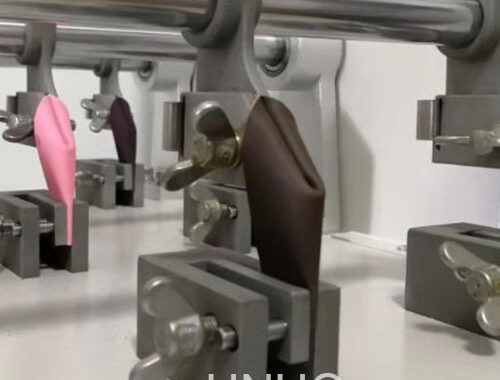ISO 5402-1 (IULTCS/IUP 20) is a method to test leather dry or wet flex resistance.…

Bally Leather Flexing Tester – Unuo
1. What is Bally Leather Flexing Tester?
Bally leather flexing tester is a flexometer to determine resistance of light leathers and their surface finishes to flexing. This leather flexing tester is also used to determine tendency for cracks to form in the creases caused by walking. Except for leather, bally flexometer is applicable to all flexible materials especially for materials used in footwear uppers.
2. Bally Flexing Test Method
Bally flexing tester test method includes ISO 5402, SATRA TM55, DIN 53351, ISO 17694, ASTM D6182, GB/T 3903.41, GB/T 20991 and etc.
3. Bally Leather Flexing Test Procedure
The test specimen is folded in half then one end is secured in a clamp. The test specimen is then turned inside out and the free end secured in a second clamp at 90 degrees to the first. The first clamp is repeatedly oscillated through a fixed flexing angle at a defined rate causing the test specimen to flex. At set intervals the number of flexing cycles is recorded and the damage to the test specimen is visually assessed. The test can be carried out with wet or dry test specimens and at ambient or sub-zero temperatures.
Vamp flex tester is another leather flexing method as below.
4. Bally Flex Tester – Leather Flexing Test Method Comparison
| SATRA TM55 | BS EN ISO 5402-1: 2017 | ISO 17694: 2016 | |
| Sample Size | 70±5mm×45±5mm | 70±1mm×45±1mm | 70±1mm×45±1mm |
| Sample number | Leather: 2
Textile: 4 |
≥4 |
Leather: 2
Textile: 4 |
| Test environment | 23±2℃/50±2%或20±2℃/65±2% | 23±2℃/50±5% | 23±2℃/50±5% |
| Test period | ≥48h | ≥24h | ≥24h |
| Test temp | 20℃/-5℃/-30℃ | 23±2℃/50±5% | 23±2℃/50±5%/
-5℃/-30℃ |
| Flexing angle | 22.5±0.5° | 22.5±0.5° | 22.3±0.3° |
| Flexing speed | 100±5 cycles/min | 100±5 cycles/min | 100±5 cycles/min |
| Upper grip | A | B | A |
| Wet sample | 1cm3 Deionized water, Reverse wetting | Vacuum dryer,
pressure≤4kpa |
Vacuum dryer,
pressure≤4kpa |
5. Bally Flex Test Result/Report
Depending on the sample and the test environment, the sample must be removed after the specified number of tests to visually observe and record the damage. Except for the routine inspection stage, wet samples must be re-wet after the specified number of tests.
After each test stage is completed, the damage status of the test sample shall be recorded:
- No abnormalities or slight creases,
- obvious or severe creases,
- Slight cracking,
- Severe cracking,
- Total destruction.
In addition, it is necessary to record whether there is salting-out phenomenon after the bally flexing test, the textile needs to record the number or degree of yarn breakage, and the surface coating records the delamination or delamination phenomenon.
Testing Report:
- Reference test method
- Sample material description
- Dry test or wet test sample
- Test temperature
- Type and severity of each sample at each stage
- Record any deviations from standard methods
More details, welcome to contact us.
- email: info@unuo-instruments.com
- Whatsapp:+86 15205060783



